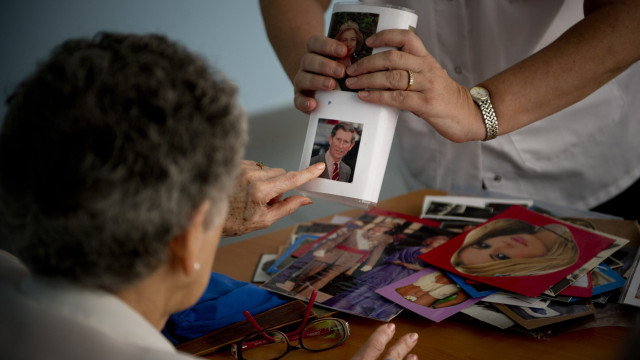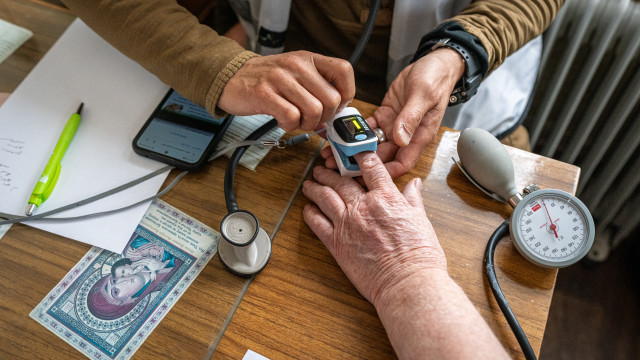



























See Also
See Again
© Shutterstock
0 / 28 Fotos
What is Usher syndrome?
- Usher syndrome is a genetic disorder that can affect vision, hearing, and balance. The syndrome was named after Scottish ophthalmologist Charles Usher in 1914.
© Public Domain
1 / 28 Fotos
Causes
- As an inherited condition, the genetic mutations are passed on through DNA. For the syndrome to occur, both parents must carry one or more mutated genes.
© Shutterstock
2 / 28 Fotos
Causes
- There are at least 10 known gene mutations that can lead to the syndrome. These mutations then affect people in different ways.
© Shutterstock
3 / 28 Fotos
Symptoms: hearing loss
- One of the main symptoms of Usher syndrome is hearing loss. This tends to be quite severe; some babies are even born completely deaf.
© Shutterstock
4 / 28 Fotos
Symptoms: vision loss
- Vision loss is also a symptom of Usher syndrome. This is caused by a condition called retinitis pigmentosa (RP).
© Shutterstock
5 / 28 Fotos
Symptoms: vision loss
- Vision loss tends to be progressive, starting with difficulty in seeing in low light, progressing to tunnel vision (loss of peripheral vision), and potentially then progressing into blindness.
© Shutterstock
6 / 28 Fotos
Symptoms: signs of vision loss in children
- Children may find it difficult to move around in the dark. They may also take longer to adjust to changes in lighting, as well as not seeing or even tripping over objects.
© Shutterstock
7 / 28 Fotos
Symptoms: balance
- Balance affects those with a specific type of Usher syndrome, often present from birth. Not every person with the syndrome experiences balance issues though.
© Shutterstock
8 / 28 Fotos
Types of Usher syndrome
- Depending on the affected genes, and their combination, hearing, vision, and balance are affected in different ways at different ages. Let’s take a look at the most common types.
© Shutterstock
9 / 28 Fotos
Types of Usher syndrome: type 1
- Those with type 1 are born with hearing loss. Babies may be born with profound hearing loss or complete deafness.
© Shutterstock
10 / 28 Fotos
Types of Usher syndrome: type 1
- Vision loss is progressive and usually starts with loss of night vision by around age 10. Vision loss becomes more severe as the person grows older.
© Shutterstock
11 / 28 Fotos
Types of Usher syndrome: type 1
- Balance issues may manifest when the child starts to walk. Trouble sitting up is also often reported in those with type 1 Usher syndrome.
© Shutterstock
12 / 28 Fotos
Types of Usher syndrome: type 2
- Those with type 2 Usher syndrome are born with hearing loss, but don’t experience balance issues. Vision problems tend to develop gradually during adolescence and evolve to severe vision loss later in life.
© Shutterstock
13 / 28 Fotos
Types of Usher syndrome: type 3
- Balance is not affected in those with type 3 Usher syndrome. As for vision and hearing problems, they are not present from birth and tend to develop in late childhood, progressively getting worse.
© Shutterstock
14 / 28 Fotos
How common is it?
- Usher syndrome is a rare condition. It’s estimated that it affects between three and six out of every 100,000 people. According to the Usher Syndrome Coalition, there are about 400,000 people who have Usher syndrome worldwide.
© Shutterstock
15 / 28 Fotos
How is it passed down from parent to child?
- As mentioned previously, both parents must carry Usher syndrome genes, meaning that these are inherited in an autosomal recessive pattern.
© Shutterstock
16 / 28 Fotos
Risk factors
- A child has a one in four chance of having Usher syndrome if the genetic mutation is present in both biological parents.
© Shutterstock
17 / 28 Fotos
Risk factors
- If the mutation is only present in one of the parents, then the child will carry the gene that causes Usher syndrome but most likely won’t have any symptoms.
© Shutterstock
18 / 28 Fotos
Diagnosis: hearing
- Diagnosis will depend on the symptoms. For instance, if a child is born with hearing problems, then hearing tests will be conducted. Genetic testing may also be done to rule out Usher syndrome or other conditions.
© Shutterstock
19 / 28 Fotos
Diagnosis: vision
- Vision tests can also be prescribed. These often include tests for retinitis pigmentosa. An electroretinography (ERG) may be performed to check how the retina responds to light.
© Shutterstock
20 / 28 Fotos
Diagnosis: vision
- An optical coherence tomography (OCT) may also be performed. This noninvasive imaging test uses light waves to take a picture of the retina.
© Shutterstock
21 / 28 Fotos
Diagnosis: vision
- Fundus autofluorescence (FAF) imaging is also an option when it comes to diagnosis tools. Blue light is used to take a picture of the retina.
© Shutterstock
22 / 28 Fotos
Diagnosis: balance
- One test that can be performed when balance is affected is a videonystagmography. The test checks for eye movements that can't be controlled, which is a sign of balance issues.
© Shutterstock
23 / 28 Fotos
Treatment: cochlear implants
- Cochlear implants are good options for babies born with hearing loss. These small electronic devices can really make a difference.
© Shutterstock
24 / 28 Fotos
Treatment: hearing aids
- There are an array of hearing aids available. These may be a good choice for those with type 2 or 3 Usher syndrome, who start to develop hearing problems later in life.
© Shutterstock
25 / 28 Fotos
Treatment: vision aids
- Eyeglasses can be prescribed at any stage of the syndrome. Other vision aids may also be recommended (e.g. magnifiers, etc.).
© Shutterstock
26 / 28 Fotos
Living with the syndrome
- Usher syndrome doesn't have a cure. Early intervention services may be offered to children born with the syndrome, while others will benefit from management of symptoms throughout their lifetime. Sources: (Cleveland Clinic) (Usher Syndrome Coalition) (National Center on Deaf-Blindness) See also: Genetic mutations that increase vulnerability to certain disorders
© Shutterstock
27 / 28 Fotos
© Shutterstock
0 / 28 Fotos
What is Usher syndrome?
- Usher syndrome is a genetic disorder that can affect vision, hearing, and balance. The syndrome was named after Scottish ophthalmologist Charles Usher in 1914.
© Public Domain
1 / 28 Fotos
Causes
- As an inherited condition, the genetic mutations are passed on through DNA. For the syndrome to occur, both parents must carry one or more mutated genes.
© Shutterstock
2 / 28 Fotos
Causes
- There are at least 10 known gene mutations that can lead to the syndrome. These mutations then affect people in different ways.
© Shutterstock
3 / 28 Fotos
Symptoms: hearing loss
- One of the main symptoms of Usher syndrome is hearing loss. This tends to be quite severe; some babies are even born completely deaf.
© Shutterstock
4 / 28 Fotos
Symptoms: vision loss
- Vision loss is also a symptom of Usher syndrome. This is caused by a condition called retinitis pigmentosa (RP).
© Shutterstock
5 / 28 Fotos
Symptoms: vision loss
- Vision loss tends to be progressive, starting with difficulty in seeing in low light, progressing to tunnel vision (loss of peripheral vision), and potentially then progressing into blindness.
© Shutterstock
6 / 28 Fotos
Symptoms: signs of vision loss in children
- Children may find it difficult to move around in the dark. They may also take longer to adjust to changes in lighting, as well as not seeing or even tripping over objects.
© Shutterstock
7 / 28 Fotos
Symptoms: balance
- Balance affects those with a specific type of Usher syndrome, often present from birth. Not every person with the syndrome experiences balance issues though.
© Shutterstock
8 / 28 Fotos
Types of Usher syndrome
- Depending on the affected genes, and their combination, hearing, vision, and balance are affected in different ways at different ages. Let’s take a look at the most common types.
© Shutterstock
9 / 28 Fotos
Types of Usher syndrome: type 1
- Those with type 1 are born with hearing loss. Babies may be born with profound hearing loss or complete deafness.
© Shutterstock
10 / 28 Fotos
Types of Usher syndrome: type 1
- Vision loss is progressive and usually starts with loss of night vision by around age 10. Vision loss becomes more severe as the person grows older.
© Shutterstock
11 / 28 Fotos
Types of Usher syndrome: type 1
- Balance issues may manifest when the child starts to walk. Trouble sitting up is also often reported in those with type 1 Usher syndrome.
© Shutterstock
12 / 28 Fotos
Types of Usher syndrome: type 2
- Those with type 2 Usher syndrome are born with hearing loss, but don’t experience balance issues. Vision problems tend to develop gradually during adolescence and evolve to severe vision loss later in life.
© Shutterstock
13 / 28 Fotos
Types of Usher syndrome: type 3
- Balance is not affected in those with type 3 Usher syndrome. As for vision and hearing problems, they are not present from birth and tend to develop in late childhood, progressively getting worse.
© Shutterstock
14 / 28 Fotos
How common is it?
- Usher syndrome is a rare condition. It’s estimated that it affects between three and six out of every 100,000 people. According to the Usher Syndrome Coalition, there are about 400,000 people who have Usher syndrome worldwide.
© Shutterstock
15 / 28 Fotos
How is it passed down from parent to child?
- As mentioned previously, both parents must carry Usher syndrome genes, meaning that these are inherited in an autosomal recessive pattern.
© Shutterstock
16 / 28 Fotos
Risk factors
- A child has a one in four chance of having Usher syndrome if the genetic mutation is present in both biological parents.
© Shutterstock
17 / 28 Fotos
Risk factors
- If the mutation is only present in one of the parents, then the child will carry the gene that causes Usher syndrome but most likely won’t have any symptoms.
© Shutterstock
18 / 28 Fotos
Diagnosis: hearing
- Diagnosis will depend on the symptoms. For instance, if a child is born with hearing problems, then hearing tests will be conducted. Genetic testing may also be done to rule out Usher syndrome or other conditions.
© Shutterstock
19 / 28 Fotos
Diagnosis: vision
- Vision tests can also be prescribed. These often include tests for retinitis pigmentosa. An electroretinography (ERG) may be performed to check how the retina responds to light.
© Shutterstock
20 / 28 Fotos
Diagnosis: vision
- An optical coherence tomography (OCT) may also be performed. This noninvasive imaging test uses light waves to take a picture of the retina.
© Shutterstock
21 / 28 Fotos
Diagnosis: vision
- Fundus autofluorescence (FAF) imaging is also an option when it comes to diagnosis tools. Blue light is used to take a picture of the retina.
© Shutterstock
22 / 28 Fotos
Diagnosis: balance
- One test that can be performed when balance is affected is a videonystagmography. The test checks for eye movements that can't be controlled, which is a sign of balance issues.
© Shutterstock
23 / 28 Fotos
Treatment: cochlear implants
- Cochlear implants are good options for babies born with hearing loss. These small electronic devices can really make a difference.
© Shutterstock
24 / 28 Fotos
Treatment: hearing aids
- There are an array of hearing aids available. These may be a good choice for those with type 2 or 3 Usher syndrome, who start to develop hearing problems later in life.
© Shutterstock
25 / 28 Fotos
Treatment: vision aids
- Eyeglasses can be prescribed at any stage of the syndrome. Other vision aids may also be recommended (e.g. magnifiers, etc.).
© Shutterstock
26 / 28 Fotos
Living with the syndrome
- Usher syndrome doesn't have a cure. Early intervention services may be offered to children born with the syndrome, while others will benefit from management of symptoms throughout their lifetime. Sources: (Cleveland Clinic) (Usher Syndrome Coalition) (National Center on Deaf-Blindness) See also: Genetic mutations that increase vulnerability to certain disorders
© Shutterstock
27 / 28 Fotos
Understanding Usher syndrome
The condition mostly manifests during childhood
© Shutterstock
Usher syndrome is a genetic condition that primarily manifests in children. The inherited disorder can affect vision, hearing, and balance. Depending on the specific type of Usher syndrome, symptoms can appear in newborns or only later in life.
In this gallery, we look at the causes, symptoms, and treatments available for those born with Usher syndrome. Click on for more.
RECOMMENDED FOR YOU




























MOST READ
- Last Hour
- Last Day
- Last Week








